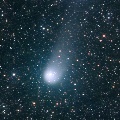
|
Now it is bright as 8.6 mag (July 4, Marco Goiato). It is observable at 7.5-8 mag for a long time from 2022 to 2023. In the Northern Hemisphere, it stays observable in good condition until autumn. However, it is not observable at the high light from autumn to 2023 summer. In the Southern Hemisphere, it stays observable in good condition for a long time.
Date(TT) R.A. (2000) Decl. Delta r Elong. m1 Best Time(A, h)
July 9 17 9.34 -1 6.7 1.813 2.699 143 8.5 21:59 ( 0, 54)
July 16 16 55.19 -3 58.2 1.809 2.639 136 8.4 21:18 ( 0, 51)
|
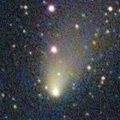
|
Now it is bright as 10.9 mag (July 4, Ken-ichi Kadota). In the Northern Hemisphere, it will be too low to observe soon. Then it will never be obsesrvable again. In the Souther Hemisphere, it is not observable until October when it fades down to 12 mag.
Date(TT) R.A. (2000) Decl. Delta r Elong. m1 Best Time(A, h)
July 9 9 1.28 31 26.3 1.959 1.136 25 9.9 21:01 (124, 5)
July 16 9 21.93 25 57.6 1.958 1.106 23 9.8 20:56 (120, 2)
|

|
Now it is very bright as 9.8 mag (June 25, Marco Goiato). It will be fading gradually after this. In the Southen Hemisphere, it stays observable in good condition for a long time, although it becomes temporarily low in August. In the Northern Hemisphere, it is not observable until November when it fades down to 13 mag.
Date(TT) R.A. (2000) Decl. Delta r Elong. m1 Best Time(A, h)
July 9 9 6.91 -54 40.5 1.667 1.811 80 10.1 21:01 ( 44,-37)
July 16 9 18.19 -50 49.7 1.799 1.831 75 10.3 20:56 ( 49,-37)
|

|
Now it is 10.3 mag (June 21, Thomas Lehmann). In the Northern Hemisphere, it is already unobservable. In the Southern Hemisphere, it becomes unobservable temporarily from July to August.
Date(TT) R.A. (2000) Decl. Delta r Elong. m1 Best Time(A, h)
July 9 8 12.16 3 43.3 4.820 3.912 23 11.3 21:01 (111,-21)
July 16 8 19.52 2 39.2 4.869 3.938 21 11.4 20:56 (113,-25)
|

|
Now it is very bright as 12.8 mag (June 23, Thomas Lehmann). It will be unobservable soon.
Date(TT) R.A. (2000) Decl. Delta r Elong. m1 Best Time(A, h)
July 9 5 18.59 20 2.5 1.310 0.603 26 12.0 3:08 (245, -1)
July 16 6 3.12 19 23.9 1.410 0.615 22 12.3 3:15 (244, -3)
|

|
Now it is bright as 12.7 mag (July 2, Thomas Lehmann). It stays 12 mag for a while. It becomes unobservable from August to November in the Northern Hemisphere, or from September to December in the Southern Hemisphere.
Date(TT) R.A. (2000) Decl. Delta r Elong. m1 Best Time(A, h)
July 9 12 9.63 -4 30.9 4.351 4.250 77 12.0 21:01 ( 68, 21)
July 16 12 14.97 -4 4.9 4.458 4.253 71 12.1 20:56 ( 71, 18)
|
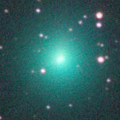
|
Now it is very bright as 11.3 mag (July 5, Thomas Lehmann). It will be fading after this. In the Southern Hemisphere, it stays observable in good condition for a long time. In the Northern Hemisphere, it will never be observable again.
Date(TT) R.A. (2000) Decl. Delta r Elong. m1 Best Time(A, h)
July 9 3 53.20 -24 35.5 1.925 1.796 67 12.3 3:08 (293,-10)
July 16 4 4.67 -29 28.2 1.915 1.881 72 12.7 3:15 (300, -8)
|
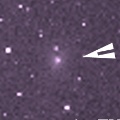
|
Now it is 11.7 mag (July 5, Thomas Lehmann). It stays observable in good condition after this. But it will be fading gradually after this.
Date(TT) R.A. (2000) Decl. Delta r Elong. m1 Best Time(A, h)
July 9 1 11.77 3 23.9 1.642 1.910 88 12.3 3:08 (297, 38)
July 16 1 20.19 3 51.7 1.607 1.948 93 12.4 3:15 (303, 43)
|

|
Now it is 11.2 mag (July 4, Ken-ichi Kadota). It is brighter than originally predicted by 3 mag. It brightened up to 6.7 mag in early May (May 10, Mike Olason). Now it is fading rapidly. The condition is very bad in this apparition. It is observable only in the extremely low sky from mid May to mid July in the Northern Hemisphere, or from early June to early August in the Southern Hemisphere.
Date(TT) R.A. (2000) Decl. Delta r Elong. m1 Best Time(A, h)
July 9 9 37.91 17 6.2 2.115 1.405 34 12.4 21:01 (108, 4)
July 16 9 59.80 15 17.7 2.231 1.496 33 12.9 20:56 (107, 2)
|

|
Now it is 13.6 mag (July 1, Thomas Lehmann). It will brighten up to 12.5 mag in summer. In the Southern Hemisphere, it stays observable in excellent condition for a long time. In the Northern Hemisphere, it is not observable until August.
Date(TT) R.A. (2000) Decl. Delta r Elong. m1 Best Time(A, h)
July 9 19 7.18 -62 57.9 2.190 3.036 139 12.5 0:05 ( 0, -8)
July 16 18 29.61 -60 49.8 2.181 3.021 138 12.5 22:51 ( 0, -6)
|

|
Now it is 12.8 mag (July 2, Thomas Lehmann). It is expected to brighten up to 11-12 mag from summer to autumn. It stays observable in good condition in the Southern Hemisphere. In the Northern Hemisphere, it becomes extremely low from August to September.
Date(TT) R.A. (2000) Decl. Delta r Elong. m1 Best Time(A, h)
July 9 11 17.30 11 3.6 1.309 1.182 59 13.2 21:01 ( 89, 20)
July 16 11 34.09 8 6.7 1.276 1.131 57 12.8 20:56 ( 87, 17)
|
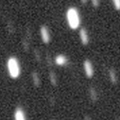
|
Now it is 13.5 mag (July 3, Michael Jager). It will approach to Earth down to 0.29 a.u. in 2023 February, and it is expected to brighten up to 5 mag. In the Northern Hemisphere, it stays observable in excellent condition. In the Southern Hemisphere, it becomes unobservable from late September to early February.
Date(TT) R.A. (2000) Decl. Delta r Elong. m1 Best Time(A, h)
July 9 18 40.55 33 36.2 2.213 2.901 123 13.4 23:29 ( 0, 89)
July 16 18 20.84 34 49.6 2.165 2.822 120 13.2 22:42 ( 0, 90)
|
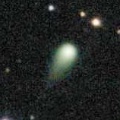
|
Now it is 13.3 mag (July 2, Thomas Lehmann). It is expected to brighten up to 10 mag in 2023. In the Northern Hemisphere, it stays observable in good condition until 2023 autumn. In the Southern Hemipshere, it stays unobservable until 2023 summer.
Date(TT) R.A. (2000) Decl. Delta r Elong. m1 Best Time(A, h)
July 9 9 54.41 54 46.4 4.625 3.962 44 13.3 21:01 (140, 26)
July 16 9 56.67 54 14.7 4.605 3.905 41 13.2 20:56 (141, 23)
|

|
Now it is 13.0 mag (July 4, Thomas Lehmann). It stays observable at 13-14 mag for a while.
Date(TT) R.A. (2000) Decl. Delta r Elong. m1 Best Time(A, h)
July 9 18 43.35 -31 59.1 2.036 3.040 168 13.2 23:34 ( 0, 23)
July 16 18 38.21 -32 13.3 2.055 3.040 162 13.3 23:01 ( 0, 23)
|

|
Now it is 14.2 mag (July 3, Thomas Lehmann). It stays 13-14 mag for a while. It is observable in excellent condition in the Southern Hemisphere. It locates somewhat low in the Northern Hemisphere.
Date(TT) R.A. (2000) Decl. Delta r Elong. m1 Best Time(A, h)
July 9 23 13.58 -22 20.7 1.184 1.949 124 13.4 3:08 (344, 31)
July 16 23 14.23 -23 14.2 1.168 1.987 130 13.5 3:15 (353, 32)
|
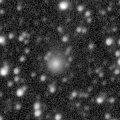
|
Now it is 13.6 mag (July 4, Thomas Lehmann). It is expected to brighten up to 11 mag in 2023. In the Northern Hemisphere, it stays observable in good condition until November. But it becomes unobservable after that. In the Southern Hemisphere, it stays observable in good condition for a long time, although it becomes unobservable temporarily from November to January.
Date(TT) R.A. (2000) Decl. Delta r Elong. m1 Best Time(A, h)
July 9 17 58.64 13 26.9 3.390 4.219 139 13.5 22:49 ( 0, 68)
July 16 17 50.92 11 56.5 3.373 4.176 137 13.5 22:13 ( 0, 67)
|
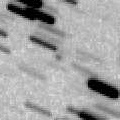
|
In the Southern Hemisphere, it is appearing in the morning sky. It stays observable in good condition after this. In the Northern Hemisphere, it is not observable at all.
Date(TT) R.A. (2000) Decl. Delta r Elong. m1 Best Time(A, h)
July 9 7 39.32 -53 31.6 1.142 1.335 76 13.5 21:01 ( 46,-49)
July 16 9 5.00 -53 24.9 1.183 1.377 77 13.8 20:56 ( 46,-39)
|
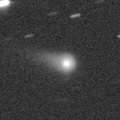
|
Now it is 13.8 mag (July 2, Michael Jager). It is expected to brighten up to 12 mag in 2023. In the Northern Hemisphere, it stays observable in good condition for a long time. In the Southern Hemisphere, it locates extremely low in 2022, but it will be observable in good condition in 2023.
Date(TT) R.A. (2000) Decl. Delta r Elong. m1 Best Time(A, h)
July 9 13 38.89 34 24.7 4.325 4.318 82 13.7 21:01 (100, 59)
July 16 13 34.19 32 45.6 4.390 4.286 77 13.7 20:56 ( 99, 53)
|

|
Now it is 13.9 mag (June 24, Chris Wyatt). It becomes too low to observe in mid August in the Northern Hemisphere, or in late September in the Southern Hemisphere.
Date(TT) R.A. (2000) Decl. Delta r Elong. m1 Best Time(A, h)
July 9 11 15.15 5 23.2 2.501 2.198 61 14.0 21:01 ( 85, 16)
July 16 11 27.22 3 56.8 2.564 2.197 57 14.1 20:56 ( 85, 13)
|

|
Now it is not observable. It will be observable again in August.
Date(TT) R.A. (2000) Decl. Delta r Elong. m1 Best Time(A, h)
July 9 5 58.00 29 14.2 6.962 6.002 17 14.1 3:08 (232, -2)
July 16 6 4.05 29 13.1 6.927 6.005 22 14.0 3:15 (236, 3)
|

|
Now it is not observable. It will appear in the morning sky in September in the Northern Hemisphere, or in November in the Southern Hemisphere. It will brighten up to 11.5 mag in winter
Date(TT) R.A. (2000) Decl. Delta r Elong. m1 Best Time(A, h)
July 9 6 54.65 21 33.8 3.202 2.189 3 14.5 3:08 (228,-16)
July 16 7 10.58 21 14.5 3.155 2.149 6 14.4 3:15 (231,-14)
|
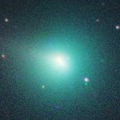
|
It brightened up to 8.8 mag from winter to early spring (Jan. 31, Chris Wyatt). Now it is fading. It has already faded down to 13.0 mag (July 2, Thomas Lehmann). It locates extremely low in the Southern Hemisphere. It will be unobservable in August in the Northern Hemisphere.
Date(TT) R.A. (2000) Decl. Delta r Elong. m1 Best Time(A, h)
July 9 9 58.19 35 20.8 2.862 2.160 38 14.7 21:01 (121, 17)
July 16 10 15.05 33 54.0 2.949 2.212 36 14.9 20:56 (120, 16)
|

|
Now it is 14.5 mag (June 19, ATLAS South Africa). It was expected to brighten up to 13 mag in spring. But actually, it is fainter than originally expected. In the Southern Hemisphere, it stays observable in good condition for a long time. In the Northern Hemisphere, it is not observable until autumn.
Date(TT) R.A. (2000) Decl. Delta r Elong. m1 Best Time(A, h)
July 9 6 41.99 -39 12.1 3.485 3.139 62 15.0 3:08 (292,-48)
July 16 6 44.06 -39 7.4 3.491 3.145 61 15.0 3:15 (294,-42)
|
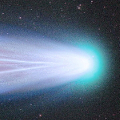
|
It brightened up to 3 mag from mid December to late December. Now it is fading. It has already faded down to 13.4 mag (May 28, Thomas Lehmann). It is observable in good condition in the Southern Hemisphere. It is getting observable again also in the Northern Hemisphere.
Date(TT) R.A. (2000) Decl. Delta r Elong. m1 Best Time(A, h)
July 9 16 27.55 -29 53.0 2.225 3.095 142 15.1 21:18 ( 0, 25)
July 16 16 17.38 -28 22.8 2.392 3.182 133 15.4 20:56 ( 4, 27)
|

|
Now it is 15.2 mag (June 28, S. L. Ferreira). It stays at 15-16 mag for a long time. In the Southern Hemisphere, it stays observable in excellent condition for a long time. In the Northern Hemiphere, it locates extremely low in spring.
Date(TT) R.A. (2000) Decl. Delta r Elong. m1 Best Time(A, h)
July 9 14 46.42 -50 16.8 4.732 5.342 122 15.2 21:01 ( 13, 3)
July 16 14 39.49 -49 59.2 4.841 5.361 115 15.2 20:56 ( 18, 1)
|

|
The condition is worst in this apparition. It is not observable at all.
Date(TT) R.A. (2000) Decl. Delta r Elong. m1 Best Time(A, h)
July 9 8 27.81 18 49.5 2.293 1.364 18 16.3 21:01 (120, -8)
July 16 8 50.43 17 54.6 2.249 1.311 16 15.6 20:56 (119, -9)
|
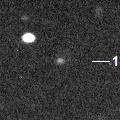
|
Appearing in the morning sky. It will brighten up to 15 mag from summer to winter, and it stays observable in good condition. It locates somwwhat low in the Southern Hemisphere.
Date(TT) R.A. (2000) Decl. Delta r Elong. m1 Best Time(A, h)
July 9 4 38.58 17 51.0 3.083 2.340 36 16.1 3:08 (252, 5)
July 16 4 52.90 18 22.5 3.032 2.335 39 16.0 3:15 (254, 10)
|

|
It is expected to brighten up to 12 mag from winter to summer in 2023. In the Northern Hemisphere, it stays observable in good condition until 2023 spring. It will be observable in good condition after August also in the Southern Hemisphere.
Date(TT) R.A. (2000) Decl. Delta r Elong. m1 Best Time(A, h)
July 9 4 18.01 39 7.9 4.598 3.879 40 16.2 3:08 (236, 21)
July 16 4 25.67 38 50.4 4.473 3.820 44 16.1 3:15 (239, 25)
|

|
Now it is 16.7 mag (June 30, Ken-ichi Kadota). It will be fading gradually after this. It locates somewhat low in the Northern Hemisphere.
Date(TT) R.A. (2000) Decl. Delta r Elong. m1 Best Time(A, h)
July 9 19 42.85 -26 9.2 2.227 3.237 171 16.1 0:38 ( 0, 29)
July 16 19 38.04 -26 39.2 2.234 3.247 174 16.1 0:05 ( 0, 28)
|

|
Now it is 16.9 mag (July 1, Ken-ichi Kadota). It is expected to brighten up to 15 mag in autumn, and it will be observable in good condition.
Date(TT) R.A. (2000) Decl. Delta r Elong. m1 Best Time(A, h)
July 9 0 46.07 4 33.5 1.963 2.275 94 16.3 3:08 (302, 44)
July 16 0 55.08 5 10.1 1.871 2.257 98 16.2 3:15 (308, 48)
|

|
It is expected to brighten very rapidly up to 11-12 mag in winter, and it will be observable in excellent condition.
Date(TT) R.A. (2000) Decl. Delta r Elong. m1 Best Time(A, h)
July 9 3 51.60 12 9.7 2.691 2.157 48 16.4 3:08 (263, 12)
July 16 4 6.72 12 41.7 2.608 2.129 51 16.2 3:15 (265, 16)
|

|
It brightened up to 12.3 mag from spring to summer in 2021 (June 15, 2021, Marco Goiato). Now it is fading. It has already faded down to 15.5 mag (June 29, ATLAS-MLO, Mauna Loa).
Date(TT) R.A. (2000) Decl. Delta r Elong. m1 Best Time(A, h)
July 9 11 59.89 30 45.4 5.586 5.220 63 16.3 21:01 (104, 38)
July 16 12 0.04 30 27.3 5.726 5.265 58 16.4 20:56 (106, 34)
|
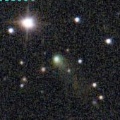
|
Now it is 16.1 mag (July 2, Thomas Lehmann). It stays observable at 16 mag from 2021 to 2022. It locates low in the Southern Hemisphere.
Date(TT) R.A. (2000) Decl. Delta r Elong. m1 Best Time(A, h)
July 9 15 25.35 43 4.5 4.983 5.196 96 16.3 21:01 (136, 78)
July 16 15 23.82 42 50.8 5.069 5.219 92 16.4 20:56 (125, 75)
|

|
Now it is 16.3 mag (July 1, Ken-ichi Kadota). It brightened up to 14 mag from 2020 to 2021. Now it is fading slowly. It is observable at 16.5-17 mag in 2022.
Date(TT) R.A. (2000) Decl. Delta r Elong. m1 Best Time(A, h)
July 9 0 47.66 -13 58.4 3.442 3.766 100 16.5 3:08 (316, 29)
July 16 0 50.06 -14 15.1 3.366 3.784 106 16.5 3:15 (324, 33)
|

|
Now it is 16.9 mag (June 17, Giuseppe Pappa). It will brighten up to 16.5 mag in July. In 2022, it stays observable for a long time.
Date(TT) R.A. (2000) Decl. Delta r Elong. m1 Best Time(A, h)
July 9 0 22.18 7 51.7 0.421 1.155 98 16.6 3:08 (306, 50)
July 16 1 8.49 13 25.7 0.402 1.108 92 16.6 3:15 (296, 52)
|

|
It brightened up to 14 mag in 2021. Now it is fading. It has already faded down to 16.5 mag (July 3, Thomas Lehmann). It is observable at 16-17 mag in 2022.
Date(TT) R.A. (2000) Decl. Delta r Elong. m1 Best Time(A, h)
July 9 0 13.10 11 11.7 5.515 5.760 98 16.6 3:08 (304, 54)
July 16 0 12.27 11 51.2 5.443 5.796 105 16.6 3:15 (315, 60)
|

|
It brightened up to 14.2 mag in 2021 summer (July 18, 2021, Taras Prystavski). Now it is fading. It has already faded down to 16.6 mag (June 11, ATLAS Chile). In the Southern Hemisphere, it stays observable in good condition for a long time. It locates somewhat low in the Northern Hemisphere.
Date(TT) R.A. (2000) Decl. Delta r Elong. m1 Best Time(A, h)
July 9 2 17.14 -25 0.4 4.890 4.919 85 16.8 3:08 (307, 7)
July 16 2 19.19 -25 2.2 4.843 4.959 90 16.8 3:15 (312, 12)
|

|
Now it is 16.2 mag (June 30, Ken-ichi Kadota). It will be observable at 16.5 mag in good condition from summer to autumn.
Date(TT) R.A. (2000) Decl. Delta r Elong. m1 Best Time(A, h)
July 9 2 18.14 19 35.3 2.364 2.193 67 16.9 3:08 (269, 35)
July 16 2 29.79 20 42.7 2.308 2.207 71 16.9 3:15 (271, 40)
|

|
Now it is 16.6 mag (June 26, Ken-ichi Kadota). It was observed at 15 mag in 2021. Now it is fading. It stays observable at 16-17 mag for a while in 2022.
Date(TT) R.A. (2000) Decl. Delta r Elong. m1 Best Time(A, h)
July 9 18 6.48 30 6.3 4.786 5.436 125 16.9 22:56 ( 0, 85)
July 16 18 1.83 30 26.7 4.840 5.460 123 17.0 22:24 ( 0, 85)
|
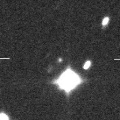
|
Now it is 17.1 mag (June 16, ATLAS-MLO, Mauna Loa). It is expected to brighten up to 12.5 mag in winter. It will become unobservable temporarily at 17 mag in July. In the Northern Hemisphere, it will become observable again in October. Then it stays observable in good condition after that. In the Southern Hemisphere, it is not observable at the high light.
Date(TT) R.A. (2000) Decl. Delta r Elong. m1 Best Time(A, h)
July 9 10 37.12 11 3.4 3.782 3.229 50 17.0 21:01 ( 95, 12)
July 16 10 41.02 11 40.7 3.811 3.164 44 16.9 20:56 ( 98, 8)
|

|
Now it is 16.9 mag (July 4, Ken-ichi Kadota). It is observable in excellent condition. But it will be fading rapidly, and it will be fainter than 18 mag in August.
Date(TT) R.A. (2000) Decl. Delta r Elong. m1 Best Time(A, h)
July 9 14 44.36 -7 51.7 0.726 1.473 114 17.0 21:01 ( 29, 42)
July 16 14 53.24 -12 34.5 0.760 1.474 111 17.1 20:56 ( 30, 37)
|

|
Now it is 17.8 mag (July 3, Michael Jager). It will brighten rapidly up to 15 mag in September, and it will be observable in good condition.
Date(TT) R.A. (2000) Decl. Delta r Elong. m1 Best Time(A, h)
July 9 23 56.32 24 51.8 1.201 1.657 96 17.3 3:08 (288, 66)
July 16 0 11.59 24 23.8 1.120 1.634 99 17.0 3:15 (295, 69)
|

|
Now it is 17.4 mag (July 1, Ken-ichi Kadota). It is observable at 17 mag in good condition from July to August.
Date(TT) R.A. (2000) Decl. Delta r Elong. m1 Best Time(A, h)
July 9 20 4.46 -2 5.7 0.956 1.930 155 17.3 1:01 ( 0, 53)
July 16 19 16.81 2 30.4 0.907 1.879 155 17.0 23:35 ( 0, 58)
|
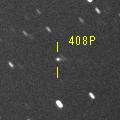
|
Appearing in the morning sky. It will be observable at 16 mag in excellent condition from autumn to winter.
Date(TT) R.A. (2000) Decl. Delta r Elong. m1 Best Time(A, h)
July 9 3 31.63 10 7.8 3.994 3.493 53 17.1 3:08 (268, 15)
July 16 3 39.84 10 7.8 3.910 3.489 58 17.0 3:15 (271, 20)
|
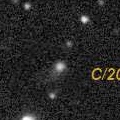
|
Now it is 17.0 mag (July 1, Ken-ichi Kadota). It stays observable at 17-18 mag for a long time until 2024.
Date(TT) R.A. (2000) Decl. Delta r Elong. m1 Best Time(A, h)
July 9 13 20.21 4 43.5 8.755 8.817 90 17.1 21:01 ( 62, 40)
July 16 13 18.87 4 45.3 8.877 8.817 83 17.1 20:56 ( 67, 36)
|

|
Now it is 16.1 mag (July 1, Masayoshi Yoshimi). It will brighten up to 15 mag in autumn, and it will be observable in excellent condition.
Date(TT) R.A. (2000) Decl. Delta r Elong. m1 Best Time(A, h)
July 9 1 58.96 2 28.8 2.623 2.610 78 17.3 3:08 (289, 29)
July 16 2 7.29 3 41.2 2.520 2.588 82 17.1 3:15 (293, 34)
|
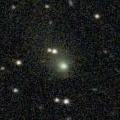
|
It became brighter after the perihelion passage, and it brightened up to 13.4 mag in early 2022 (Jan. 7, Hiroshi Abe). Now it is fading. It has already faded down to 16.1 mag (June 21, Thomas Lehmann). It will be fainter than 18 mag in summer.
Date(TT) R.A. (2000) Decl. Delta r Elong. m1 Best Time(A, h)
July 9 10 28.93 -3 3.7 4.821 4.310 54 17.2 21:01 ( 85, 2)
July 16 10 31.37 -3 56.6 4.954 4.355 49 17.4 20:56 ( 87, -3)
|

|
Now it is 16.9 mag (June 22, B. Koch). Fading slowly. In the Northern Hemisphere, it stays observable in good condition for a long time. In the Southern Hemisphere, it is not observable after this.
Date(TT) R.A. (2000) Decl. Delta r Elong. m1 Best Time(A, h)
July 9 18 8.77 68 32.4 9.233 9.259 88 17.3 22:57 (180, 56)
July 16 17 59.39 68 35.2 9.249 9.271 88 17.3 22:21 (180, 56)
|

|
It approached to Sun down to 0.14 a.u. on May 15. But it was not observable around that time. Appearing in the morning sky. In the Northern Hemisphere, it stays observable at 17-18 mag in good condition from July to November. In the Southern Hemisphere, it stays extremely low.
Date(TT) R.A. (2000) Decl. Delta r Elong. m1 Best Time(A, h)
July 9 3 37.25 34 44.2 1.668 1.245 48 17.4 3:08 (244, 26)
July 16 3 45.91 35 52.6 1.686 1.338 52 17.6 3:15 (245, 31)
|

|
Now it is 17.8 mag (June 3, Toshihiko Ikemura, Hirohisa Sato). It is observable at 17 mag from spring to summer. In the Northern Hemisphere, it becomes low in summer.
Date(TT) R.A. (2000) Decl. Delta r Elong. m1 Best Time(A, h)
July 9 12 3.18 4 50.6 2.096 2.034 72 17.4 21:01 ( 77, 26)
July 16 12 12.81 2 24.0 2.159 2.028 68 17.5 20:56 ( 77, 22)
|

|
Now it is 17.6 mag (June 7, ATLAS Chile). It will brighten up to 16 mag in 2023. In the Southern Hemisphere, it stays observable in good condition for a long time. In the Northern Hemisphere, it will never be observable again.
Date(TT) R.A. (2000) Decl. Delta r Elong. m1 Best Time(A, h)
July 9 10 3.56 -19 44.5 4.245 3.831 59 17.5 21:01 ( 74,-12)
July 16 10 9.49 -20 30.7 4.277 3.797 55 17.5 20:56 ( 76,-16)
|

|
It is expected to brighten up to 7 mag in early 2024. In the Southern Hemisphere, it stays observable in good condition for a long time. It will appear in the morning sky in mid August also in the Northern Hemisphere, but it stays low in 2022.
Date(TT) R.A. (2000) Decl. Delta r Elong. m1 Best Time(A, h)
July 9 5 37.50 -18 55.6 7.281 6.634 47 17.5 3:08 (275,-27)
July 16 5 42.07 -19 14.9 7.183 6.574 49 17.5 3:15 (279,-22)
|
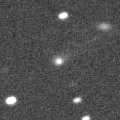
|
Now it is 17.4 mag (June 24, iTelescope Observatory, Siding Spring). It will be unobservable in September.
Date(TT) R.A. (2000) Decl. Delta r Elong. m1 Best Time(A, h)
July 9 13 13.10 -8 6.3 4.546 4.718 93 17.5 21:01 ( 53, 30)
July 16 13 15.80 -8 25.8 4.653 4.720 87 17.5 20:56 ( 57, 26)
|

|
It brightened up to 9.5 mag in early summer in 2021 (June 27, Marco Goiato). Now it is fading. It has already faded down to 17.2 mag (July 3, ATLAS Chile). In the Northern Hemisphere, it stays extremely low.
Date(TT) R.A. (2000) Decl. Delta r Elong. m1 Best Time(A, h)
July 9 23 24.27 -36 29.2 3.784 4.436 124 17.6 3:08 (345, 17)
July 16 23 23.20 -37 21.5 3.778 4.495 129 17.7 3:15 (353, 17)
|
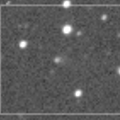
|
It was observed at 17 mag in 2021. It is observable at 17-18 mag also in 2022.
Date(TT) R.A. (2000) Decl. Delta r Elong. m1 Best Time(A, h)
July 9 2 39.38 4 36.5 3.579 3.333 67 17.6 3:08 (280, 22)
July 16 2 44.38 5 32.8 3.503 3.351 73 17.6 3:15 (284, 28)
|

|
It brightened up to 17 mag in early 2022. Now it is fading. It will be fainter than 18 mag in autumn. It is not observable in the Northern Hemisphere.
Date(TT) R.A. (2000) Decl. Delta r Elong. m1 Best Time(A, h)
July 9 7 8.42 -42 43.8 5.963 5.612 65 17.6 3:08 (297,-53)
July 16 7 12.35 -43 24.2 5.979 5.628 65 17.6 3:15 (298,-48)
|
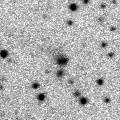
|
Now it is 17.2 mag (July 2, C. Gerhard). It started fading before the perihelion passage. It was predicted to stay at 16 mag for a long time. But actually, it will be fainter than 18 mag in autumn. In the Northern Hemisphere, it stays observable in good condition for a long time. In the Southern Hemisphere, it is not observable until 2023.
Date(TT) R.A. (2000) Decl. Delta r Elong. m1 Best Time(A, h)
July 9 19 19.72 83 27.9 3.961 3.810 74 17.7 0:13 (180, 41)
July 16 18 29.33 82 2.2 3.934 3.821 76 17.7 22:46 (180, 43)
|

|
It stays observable at 17-18 mag in 2022. It locates somewhat low in the Southern Hemisphere.
Date(TT) R.A. (2000) Decl. Delta r Elong. m1 Best Time(A, h)
July 9 2 54.82 28 54.3 5.875 5.397 57 17.7 3:08 (255, 31)
July 16 2 53.85 29 6.8 5.769 5.404 64 17.7 3:15 (258, 38)
|

|
Now it is 17.8 mag (June 10, ATLAS Chile). It is expected to brighten up to 12-13 mag from 2024 to 2025.
Date(TT) R.A. (2000) Decl. Delta r Elong. m1 Best Time(A, h)
July 9 9 57.80 -18 47.0 8.008 7.517 57 17.8 21:01 ( 76,-13)
July 16 9 59.66 -18 25.8 8.047 7.472 52 17.8 20:56 ( 79,-17)
|
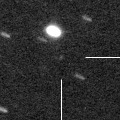
|
It is expected to brighten up to 8 mag in 2023 July. In 2022, it stays observable in good condition while the comet will be brightening gradually.
Date(TT) R.A. (2000) Decl. Delta r Elong. m1 Best Time(A, h)
July 9 3 29.86 8 15.1 5.311 4.800 54 17.9 3:08 (269, 14)
July 16 3 31.66 8 1.6 5.141 4.735 61 17.8 3:15 (274, 20)
|
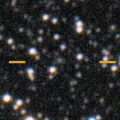
|
Now it is 17.1 mag (June 16, Mt. Lemmon Survey). It was observed at 17 mag in 2021. It is observable at 17-18 mag in 2022.
Date(TT) R.A. (2000) Decl. Delta r Elong. m1 Best Time(A, h)
July 9 23 28.34 0 13.6 3.673 4.185 113 17.9 3:08 (330, 51)
July 16 23 28.88 0 20.7 3.591 4.194 120 17.8 3:15 (342, 54)
|
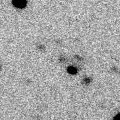
|
Now it is 17.5 mag (July 4, Michael Jager). In the Northern Hemisphere, it stays observable at 17 mag in good condition for a long time until winter. In the Southern Hemisphere, it stays extremely low for a long time.
Date(TT) R.A. (2000) Decl. Delta r Elong. m1 Best Time(A, h)
July 9 4 14.88 37 28.1 3.489 2.797 40 17.9 3:08 (238, 20)
July 16 4 30.25 38 32.3 3.430 2.789 43 17.9 3:15 (239, 24)
|

|
Now it is 18.2 mag (July 7, N. Sioulas). It will brighten up to 17.5 mag in July. But it will fade out quickly.
Date(TT) R.A. (2000) Decl. Delta r Elong. m1 Best Time(A, h)
July 9 21 58.98 -13 51.4 0.808 1.713 139 18.4 2:55 ( 0, 41)
July 16 20 53.98 -16 25.3 0.672 1.668 161 17.9 1:24 ( 0, 39)
|

|
Now it is 17.2 mag (June 25, A. Diepvens). It was observed at 16 mag from 2020 to 2021. Now it is fading. It will be fainter than 18 mag in summer.
Date(TT) R.A. (2000) Decl. Delta r Elong. m1 Best Time(A, h)
July 9 22 13.38 13 40.2 6.263 6.866 122 17.9 3:07 ( 0, 69)
July 16 22 9.58 13 8.9 6.197 6.889 129 17.9 2:36 ( 0, 68)
|

|
Now it is 17.3 mag (June 27, ATLAS South Africa). Very far object. It stays 18 mag for a long time from 2021 to 2026. In the Southern Hemisphere, it stays observable in good condition for a long time. In the Northern Hemisphere, it is not observable at all.
Date(TT) R.A. (2000) Decl. Delta r Elong. m1 Best Time(A, h)
July 9 7 47.17 -62 1.0 10.690 10.645 84 17.9 21:01 ( 34,-47)
July 16 7 50.63 -62 8.2 10.701 10.636 83 17.9 20:56 ( 33,-49)
|

|
Now it is 18.5 mag (July 3, Michael Jager). It was expected to be observable at 16 mag in good condition in spring. But actually, it is fainter than predicted by 2-3 mag.
Date(TT) R.A. (2000) Decl. Delta r Elong. m1 Best Time(A, h)
July 9 21 11.09 9 11.5 0.915 1.797 136 18.9 2:05 ( 0, 64)
July 16 21 4.80 10 17.4 0.929 1.840 142 19.0 1:32 ( 0, 65)
|
|
![]()
 C/2019 T4 ( ATLAS )
C/2019 T4 ( ATLAS ) C/2021 F1 ( Lemmon-PanSTARRS )
C/2021 F1 ( Lemmon-PanSTARRS ) 22P/Kopff
22P/Kopff 45P/Honda-Mrkos-Pajdusakova
45P/Honda-Mrkos-Pajdusakova C/2020 R7 ( ATLAS )
C/2020 R7 ( ATLAS ) 73P/Schwassmann-Wachmann 3
73P/Schwassmann-Wachmann 3 C/2022 E3 ( ZTF )
C/2022 E3 ( ZTF ) C/2020 V2 ( ZTF )
C/2020 V2 ( ZTF ) 117P/Helin-Roman-Alu 1
117P/Helin-Roman-Alu 1 9P/Tempel 1
9P/Tempel 1 C/2020 K1 ( PanSTARRS )
C/2020 K1 ( PanSTARRS ) C/2021 T2 ( Fuls )
C/2021 T2 ( Fuls ) C/2019 U5 ( PanSTARRS )
C/2019 U5 ( PanSTARRS ) 116P/Wild 4
116P/Wild 4 29P/Schwassmann-Wachmann 1
29P/Schwassmann-Wachmann 1 81P/Wild 2
81P/Wild 2 19P/Borrelly
19P/Borrelly C/2020 Y2 ( ATLAS )
C/2020 Y2 ( ATLAS ) C/2021 A1 ( Leonard )
C/2021 A1 ( Leonard ) C/2018 U1 ( Lemmon )
C/2018 U1 ( Lemmon ) 41P/Tuttle-Giacobini-Kresak
41P/Tuttle-Giacobini-Kresak 119P/Parker-Hartley
119P/Parker-Hartley C/2021 Y1 ( ATLAS )
C/2021 Y1 ( ATLAS ) 152P/Helin-Lawrence
152P/Helin-Lawrence 61P/Shajn-Schaldach
61P/Shajn-Schaldach 118P/Shoemaker-Levy 4
118P/Shoemaker-Levy 4 C/2020 J1 ( SONEAR )
C/2020 J1 ( SONEAR ) C/2020 H6 ( ATLAS )
C/2020 H6 ( ATLAS ) 246P/NEAT
246P/NEAT 107P/(4015) Wilson-Harrington
107P/(4015) Wilson-Harrington C/2020 F5 ( MASTER )
C/2020 F5 ( MASTER ) C/2019 F1 ( ATLAS-Africano )
C/2019 F1 ( ATLAS-Africano ) 44P/Reinmuth 2
44P/Reinmuth 2 C/2020 O2 ( Amaral )
C/2020 O2 ( Amaral ) C/2022 A2 ( PanSTARRS )
C/2022 A2 ( PanSTARRS ) P/2022 C4 ( WISE-PanSTARRS )
P/2022 C4 ( WISE-PanSTARRS ) 327P/Van Ness
327P/Van Ness C/2022 L1 ( Catalina )
C/2022 L1 ( Catalina ) 408P/2020 M7 ( Novichonok-Gerke )
408P/2020 M7 ( Novichonok-Gerke ) C/2020 F2 ( ATLAS )
C/2020 F2 ( ATLAS ) P/2022 L3 ( ATLAS )
P/2022 L3 ( ATLAS ) C/2020 M5 ( ATLAS )
C/2020 M5 ( ATLAS ) C/2019 O3 ( Palomar )
C/2019 O3 ( Palomar ) (3200) Phaethon
(3200) Phaethon 100P/Hartley 1
100P/Hartley 1 C/2021 C5 ( PanSTARRS )
C/2021 C5 ( PanSTARRS ) C/2021 S3 ( PanSTARRS )
C/2021 S3 ( PanSTARRS ) 99P/Kowal 1
99P/Kowal 1 C/2020 T2 ( Palomar )
C/2020 T2 ( Palomar ) 422P/2021 L1 ( Christensen )
422P/2021 L1 ( Christensen ) C/2020 F7 ( Lemmon )
C/2020 F7 ( Lemmon ) C/2020 U5 ( PanSTARRS )
C/2020 U5 ( PanSTARRS ) C/2020 U4 ( PanSTARRS )
C/2020 U4 ( PanSTARRS ) C/2022 E2 ( ATLAS )
C/2022 E2 ( ATLAS ) C/2021 T4 ( Lemmon )
C/2021 T4 ( Lemmon ) 395P/2020 H1 ( Catalina-NEAT )
395P/2020 H1 ( Catalina-NEAT ) C/2021 QM45 ( PanSTARRS )
C/2021 QM45 ( PanSTARRS ) C/2022 N1 ( Attard-Maury )
C/2022 N1 ( Attard-Maury ) C/2019 T3 ( ATLAS )
C/2019 T3 ( ATLAS ) C/2019 E3 ( ATLAS )
C/2019 E3 ( ATLAS ) 325P/Yang-Gao
325P/Yang-Gao![]()
























































